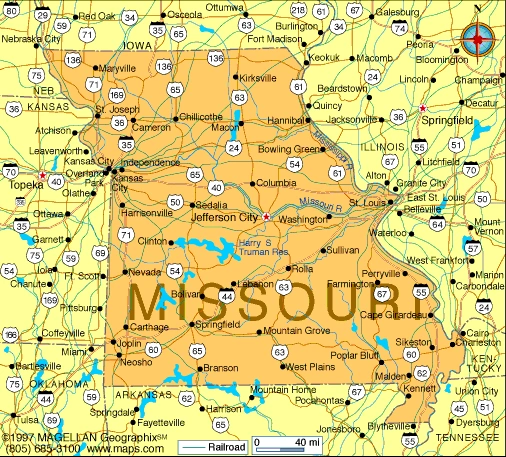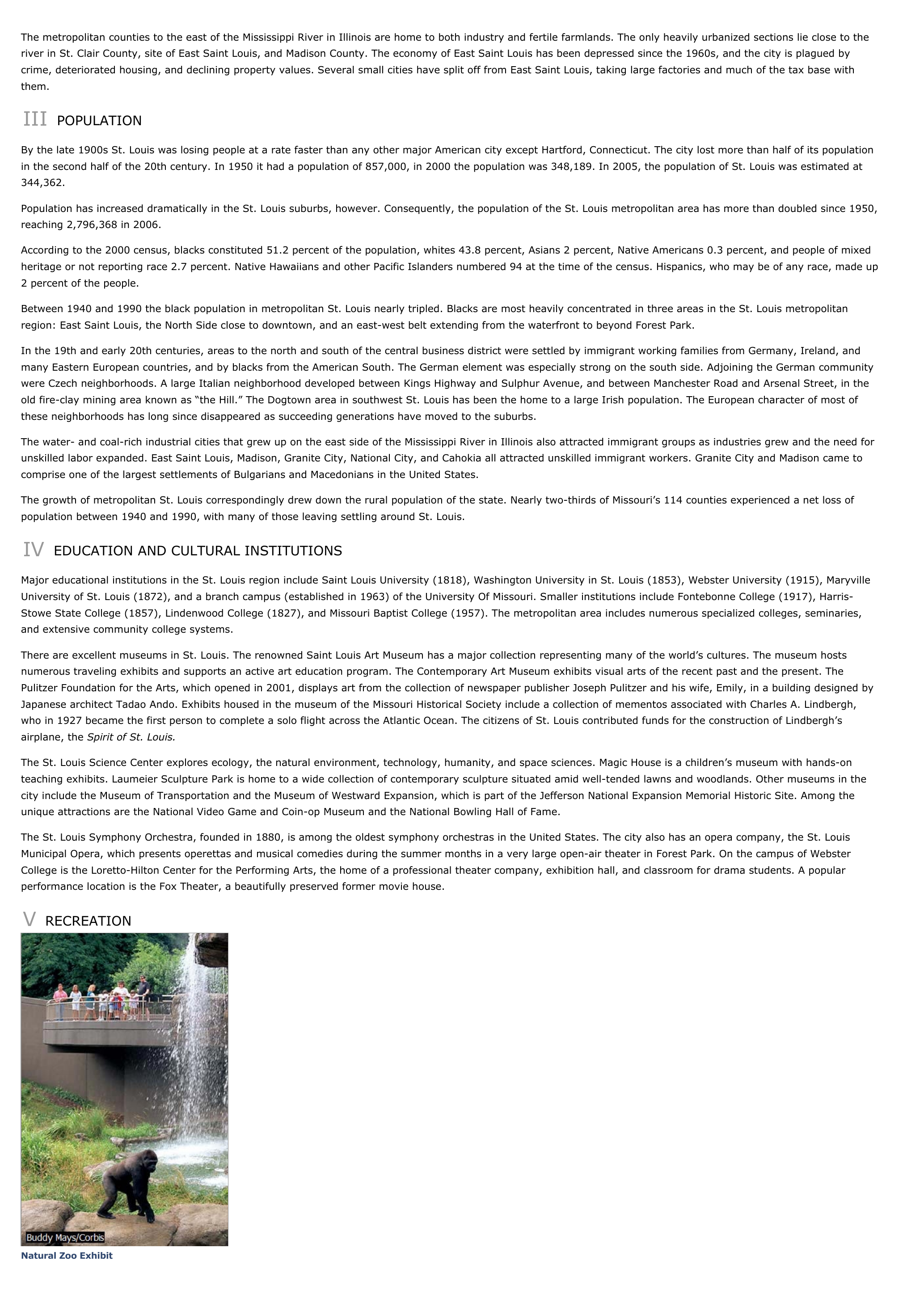St. Louis (city) - geography. I INTRODUCTION Skyline of St. Louis, Missouri St. Louis,
Publié le 27/05/2013

Extrait du document


«
The metropolitan counties to the east of the Mississippi River in Illinois are home to both industry and fertile farmlands.
The only heavily urbanized sections lie close to theriver in St.
Clair County, site of East Saint Louis, and Madison County.
The economy of East Saint Louis has been depressed since the 1960s, and the city is plagued bycrime, deteriorated housing, and declining property values.
Several small cities have split off from East Saint Louis, taking large factories and much of the tax base withthem.
III POPULATION
By the late 1900s St.
Louis was losing people at a rate faster than any other major American city except Hartford, Connecticut.
The city lost more than half of its populationin the second half of the 20th century.
In 1950 it had a population of 857,000, in 2000 the population was 348,189.
In 2005, the population of St.
Louis was estimated at344,362.
Population has increased dramatically in the St.
Louis suburbs, however.
Consequently, the population of the St.
Louis metropolitan area has more than doubled since 1950,reaching 2,796,368 in 2006.
According to the 2000 census, blacks constituted 51.2 percent of the population, whites 43.8 percent, Asians 2 percent, Native Americans 0.3 percent, and people of mixedheritage or not reporting race 2.7 percent.
Native Hawaiians and other Pacific Islanders numbered 94 at the time of the census.
Hispanics, who may be of any race, made up2 percent of the people.
Between 1940 and 1990 the black population in metropolitan St.
Louis nearly tripled.
Blacks are most heavily concentrated in three areas in the St.
Louis metropolitanregion: East Saint Louis, the North Side close to downtown, and an east-west belt extending from the waterfront to beyond Forest Park.
In the 19th and early 20th centuries, areas to the north and south of the central business district were settled by immigrant working families from Germany, Ireland, andmany Eastern European countries, and by blacks from the American South.
The German element was especially strong on the south side.
Adjoining the German communitywere Czech neighborhoods.
A large Italian neighborhood developed between Kings Highway and Sulphur Avenue, and between Manchester Road and Arsenal Street, in theold fire-clay mining area known as “the Hill.” The Dogtown area in southwest St.
Louis has been the home to a large Irish population.
The European character of most ofthese neighborhoods has long since disappeared as succeeding generations have moved to the suburbs.
The water- and coal-rich industrial cities that grew up on the east side of the Mississippi River in Illinois also attracted immigrant groups as industries grew and the need forunskilled labor expanded.
East Saint Louis, Madison, Granite City, National City, and Cahokia all attracted unskilled immigrant workers.
Granite City and Madison came tocomprise one of the largest settlements of Bulgarians and Macedonians in the United States.
The growth of metropolitan St.
Louis correspondingly drew down the rural population of the state.
Nearly two-thirds of Missouri’s 114 counties experienced a net loss ofpopulation between 1940 and 1990, with many of those leaving settling around St.
Louis.
IV EDUCATION AND CULTURAL INSTITUTIONS
Major educational institutions in the St.
Louis region include Saint Louis University (1818), Washington University in St.
Louis (1853), Webster University (1915), MaryvilleUniversity of St.
Louis (1872), and a branch campus (established in 1963) of the University Of Missouri.
Smaller institutions include Fontebonne College (1917), Harris-Stowe State College (1857), Lindenwood College (1827), and Missouri Baptist College (1957).
The metropolitan area includes numerous specialized colleges, seminaries,and extensive community college systems.
There are excellent museums in St.
Louis.
The renowned Saint Louis Art Museum has a major collection representing many of the world’s cultures.
The museum hostsnumerous traveling exhibits and supports an active art education program.
The Contemporary Art Museum exhibits visual arts of the recent past and the present.
ThePulitzer Foundation for the Arts, which opened in 2001, displays art from the collection of newspaper publisher Joseph Pulitzer and his wife, Emily, in a building designed byJapanese architect Tadao Ando.
Exhibits housed in the museum of the Missouri Historical Society include a collection of mementos associated with Charles A.
Lindbergh,who in 1927 became the first person to complete a solo flight across the Atlantic Ocean.
The citizens of St.
Louis contributed funds for the construction of Lindbergh’sairplane, the Spirit of St.
Louis.
The St.
Louis Science Center explores ecology, the natural environment, technology, humanity, and space sciences.
Magic House is a children’s museum with hands-onteaching exhibits.
Laumeier Sculpture Park is home to a wide collection of contemporary sculpture situated amid well-tended lawns and woodlands.
Other museums in thecity include the Museum of Transportation and the Museum of Westward Expansion, which is part of the Jefferson National Expansion Memorial Historic Site.
Among theunique attractions are the National Video Game and Coin-op Museum and the National Bowling Hall of Fame.
The St.
Louis Symphony Orchestra, founded in 1880, is among the oldest symphony orchestras in the United States.
The city also has an opera company, the St.
LouisMunicipal Opera, which presents operettas and musical comedies during the summer months in a very large open-air theater in Forest Park.
On the campus of WebsterCollege is the Loretto-Hilton Center for the Performing Arts, the home of a professional theater company, exhibition hall, and classroom for drama students.
A popularperformance location is the Fox Theater, a beautifully preserved former movie house.
V RECREATION
Natural Zoo Exhibit.
»
↓↓↓ APERÇU DU DOCUMENT ↓↓↓
Liens utiles
- St. Louis (city) - geography. I INTRODUCTION St. Louis (city) or Saint Louis,
- Kansas City (Missouri) - geography.
- St. John's (city, Newfoundland and Labrador) - Geography. I INTRODUCTION St. John's (city,
- Kansas City (Missouri) - geography.
- St. John's (city, Newfoundland and Labrador) - geography. I INTRODUCTION Harbor of St.

































